| Listing 1 - 10 of 10 |
Sort by
|
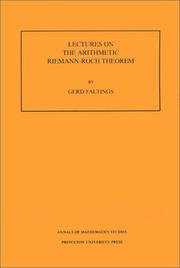
ISBN: 0691087717 0691025444 1400882478 Year: 2016 Volume: vol 127 Publisher: Princeton, NJ : Princeton University Press,
Abstract | Keywords | Export | Availability | Bookmark
 Loading...
Loading...Choose an application
- Reference Manager
- EndNote
- RefWorks (Direct export to RefWorks)
The arithmetic Riemann-Roch Theorem has been shown recently by Bismut-Gillet-Soul. The proof mixes algebra, arithmetic, and analysis. The purpose of this book is to give a concise introduction to the necessary techniques, and to present a simplified and extended version of the proof. It should enable mathematicians with a background in arithmetic algebraic geometry to understand some basic techniques in the rapidly evolving field of Arakelov-theory.
Algebraic geometry --- Algebraïsche meetkunde --- Geometry [Algebraic ] --- Géométrie algébrique --- Meetkunde [Algebraïsche ] --- Riemann-Roch theorema's --- Riemann-Roch thoerems --- Theoremes de Riemann-Roch --- Geometry, Algebraic. --- Riemann-Roch theorems. --- Theorems, Riemann-Roch --- Algebraic functions --- Geometry, Algebraic --- Geometry --- Addition. --- Adjoint. --- Alexander Grothendieck. --- Algebraic geometry. --- Analytic torsion. --- Arakelov theory. --- Asymptote. --- Asymptotic expansion. --- Asymptotic formula. --- Big O notation. --- Cartesian coordinate system. --- Characteristic class. --- Chern class. --- Chow group. --- Closed immersion. --- Codimension. --- Coherent sheaf. --- Cohomology. --- Combination. --- Commutator. --- Computation. --- Covariant derivative. --- Curvature. --- Derivative. --- Determinant. --- Diagonal. --- Differentiable manifold. --- Differential form. --- Dimension (vector space). --- Divisor. --- Domain of a function. --- Dual basis. --- E6 (mathematics). --- Eigenvalues and eigenvectors. --- Embedding. --- Endomorphism. --- Exact sequence. --- Exponential function. --- Generic point. --- Heat kernel. --- Injective function. --- Intersection theory. --- K-group. --- Levi-Civita connection. --- Line bundle. --- Linear algebra. --- Local coordinates. --- Mathematical induction. --- Morphism. --- Natural number. --- Neighbourhood (mathematics). --- Parameter. --- Projective space. --- Pullback (category theory). --- Pullback (differential geometry). --- Pullback. --- Riemannian manifold. --- Riemann–Roch theorem. --- Self-adjoint operator. --- Smoothness. --- Sobolev space. --- Stochastic calculus. --- Summation. --- Supertrace. --- Theorem. --- Transition function. --- Upper half-plane. --- Vector bundle. --- Volume form.
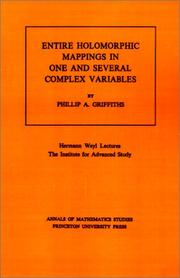
ISBN: 0691081719 0691081727 140088148X 9780691081724 9780691081717 Year: 1976 Volume: no. 85 Publisher: Princeton (N.J.) Princeton university press
Abstract | Keywords | Export | Availability | Bookmark
 Loading...
Loading...Choose an application
- Reference Manager
- EndNote
- RefWorks (Direct export to RefWorks)
The present monograph grew out of the fifth set of Hermann Weyl Lectures, given by Professor Griffiths at the Institute for Advanced Study, Princeton, in fall 1974.In Chapter 1 the author discusses Emile Borel's proof and the classical Jensen theorem, order of growth of entire analytic sets, order functions for entire holomorphic mappings, classical indicators of orders of growth, and entire functions and varieties of finite order.Chapter 2 is devoted to the appearance of curvature, and Chapter 3 considers the defect relations. The author considers the lemma on the logarithmic derivative, R. Nevanlinna's proof of the defect relation, and refinements of the classical case.
Complex analysis --- Holomorphic mappings --- Applications holomorphes --- 517.53 --- Mappings, Holomorphic --- Functions of several complex variables --- Mappings (Mathematics) --- Functions of a complex variable --- Holomorphic mappings. --- 517.53 Functions of a complex variable --- Fonctions de plusieurs variables complexes --- Fonctions entières --- Functions, Entire --- Algebraic variety. --- Analytic function. --- Analytic set. --- Armand Borel. --- Big O notation. --- Canonical bundle. --- Cartesian coordinate system. --- Characteristic function (probability theory). --- Characterization (mathematics). --- Chern class. --- Compact Riemann surface. --- Compact space. --- Complex analysis. --- Complex manifold. --- Complex projective space. --- Corollary. --- Counting. --- Curvature. --- Degeneracy (mathematics). --- Derivative. --- Differential form. --- Dimension. --- Divisor. --- Elementary proof. --- Entire function. --- Equation. --- Exponential growth. --- Gaussian curvature. --- Hermann Weyl. --- Hodge theory. --- Holomorphic function. --- Hyperplane. --- Hypersurface. --- Infinite product. --- Integral geometry. --- Invariant measure. --- Inverse problem. --- Jacobian matrix and determinant. --- Kähler manifold. --- Line bundle. --- Linear equation. --- Logarithmic derivative. --- Manifold. --- Meromorphic function. --- Modular form. --- Monograph. --- Nevanlinna theory. --- Nonlinear system. --- Phillip Griffiths. --- Picard theorem. --- Polynomial. --- Projective space. --- Q.E.D. --- Quantity. --- Ricci curvature. --- Riemann sphere. --- Scientific notation. --- Several complex variables. --- Special case. --- Stokes' theorem. --- Subset. --- Summation. --- Theorem. --- Theory. --- Uniformization theorem. --- Unit square. --- Volume form. --- Fonctions entières

ISBN: 0691082847 0691082790 1400881447 9780691082844 Year: 1981 Volume: 99 Publisher: Princeton (N.J.): Princeton university press
Abstract | Keywords | Export | Availability | Bookmark
 Loading...
Loading...Choose an application
- Reference Manager
- EndNote
- RefWorks (Direct export to RefWorks)
The theory of Toeplitz operators has come to resemble more and more in recent years the classical theory of pseudodifferential operators. For instance, Toeplitz operators possess a symbolic calculus analogous to the usual symbolic calculus, and by symbolic means one can construct parametrices for Toeplitz operators and create new Toeplitz operators out of old ones by functional operations.If P is a self-adjoint pseudodifferential operator on a compact manifold with an elliptic symbol that is of order greater than zero, then it has a discrete spectrum. Also, it is well known that the asymptotic behavior of its eigenvalues is closely related to the behavior of the bicharacteristic flow generated by its symbol.It is natural to ask if similar results are true for Toeplitz operators. In the course of answering this question, the authors explore in depth the analogies between Toeplitz operators and pseudodifferential operators and show that both can be viewed as the "quantized" objects associated with functions on compact contact manifolds.
Operator theory --- Toeplitz operators --- Spectral theory (Mathematics) --- 517.984 --- Spectral theory of linear operators --- Toeplitz operators. --- Spectral theory (Mathematics). --- 517.984 Spectral theory of linear operators --- Operators, Toeplitz --- Linear operators --- Functional analysis --- Hilbert space --- Measure theory --- Transformations (Mathematics) --- Algebraic variety. --- Asymptotic analysis. --- Asymptotic expansion. --- Big O notation. --- Boundary value problem. --- Change of variables. --- Chern class. --- Codimension. --- Cohomology. --- Compact group. --- Complex manifold. --- Complex vector bundle. --- Connection form. --- Contact geometry. --- Corollary. --- Cotangent bundle. --- Curvature form. --- Diffeomorphism. --- Differentiable manifold. --- Dimensional analysis. --- Discrete spectrum. --- Eigenvalues and eigenvectors. --- Elaboration. --- Elliptic operator. --- Embedding. --- Equivalence class. --- Existential quantification. --- Exterior (topology). --- Fourier integral operator. --- Fourier transform. --- Hamiltonian vector field. --- Holomorphic function. --- Homogeneous function. --- Hypoelliptic operator. --- Integer. --- Integral curve. --- Integral transform. --- Invariant subspace. --- Lagrangian (field theory). --- Lagrangian. --- Limit point. --- Line bundle. --- Linear map. --- Mathematics. --- Metaplectic group. --- Natural number. --- Normal space. --- One-form. --- Open set. --- Operator (physics). --- Oscillatory integral. --- Parallel transport. --- Parameter. --- Parametrix. --- Periodic function. --- Polynomial. --- Projection (linear algebra). --- Projective variety. --- Pseudo-differential operator. --- Q.E.D. --- Quadratic form. --- Quantity. --- Quotient ring. --- Real number. --- Scientific notation. --- Self-adjoint. --- Smoothness. --- Spectral theorem. --- Spectral theory. --- Square root. --- Submanifold. --- Summation. --- Support (mathematics). --- Symplectic geometry. --- Symplectic group. --- Symplectic manifold. --- Symplectic vector space. --- Tangent space. --- Theorem. --- Todd class. --- Toeplitz algebra. --- Toeplitz matrix. --- Toeplitz operator. --- Trace formula. --- Transversal (geometry). --- Trigonometric functions. --- Variable (mathematics). --- Vector bundle. --- Vector field. --- Vector space. --- Volume form. --- Wave front set. --- Opérateurs pseudo-différentiels
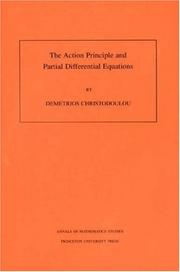
ISBN: 0691049572 0691049564 1400882680 Year: 2000 Volume: no. 146 Publisher: Princeton Princeton University press
Abstract | Keywords | Export | Availability | Bookmark
 Loading...
Loading...Choose an application
- Reference Manager
- EndNote
- RefWorks (Direct export to RefWorks)
This book introduces new methods in the theory of partial differential equations derivable from a Lagrangian. These methods constitute, in part, an extension to partial differential equations of the methods of symplectic geometry and Hamilton-Jacobi theory for Lagrangian systems of ordinary differential equations. A distinguishing characteristic of this approach is that one considers, at once, entire families of solutions of the Euler-Lagrange equations, rather than restricting attention to single solutions at a time. The second part of the book develops a general theory of integral identities, the theory of "compatible currents," which extends the work of E. Noether. Finally, the third part introduces a new general definition of hyperbolicity, based on a quadratic form associated with the Lagrangian, which overcomes the obstacles arising from singularities of the characteristic variety that were encountered in previous approaches. On the basis of the new definition, the domain-of-dependence theorem and stability properties of solutions are derived. Applications to continuum mechanics are discussed throughout the book. The last chapter is devoted to the electrodynamics of nonlinear continuous media.
Differentiaalvergelijkingen [Hyperbolische ] --- Differential equations [Hyperbolic] --- Equations différentielles hyperboliques --- Symplectic manifolds --- Differential equations, Hyperbolic. --- Symplectic manifolds. --- Variétés symplectiques --- Equations différentielles hyperboliques --- Variétés symplectiques --- Manifolds, Symplectic --- Geometry, Differential --- Manifolds (Mathematics) --- Hyperbolic differential equations --- Differential equations, Partial --- Action (physics). --- Boundary value problem. --- Canonical form. --- Causal structure. --- Classical mechanics. --- Complex analysis. --- Configuration space. --- Conservative vector field. --- Conserved current. --- Conserved quantity. --- Continuum mechanics. --- Derivative. --- Diffeomorphism. --- Differentiable manifold. --- Differential geometry. --- Dimension. --- Dimensional analysis. --- Dirichlet's principle. --- Einstein field equations. --- Electromagnetic field. --- Equation. --- Equations of motion. --- Equivalence class. --- Error term. --- Euclidean space. --- Euler system. --- Euler's equations (rigid body dynamics). --- Euler–Lagrange equation. --- Existence theorem. --- Existential quantification. --- Exponential map (Lie theory). --- Exponential map (Riemannian geometry). --- Exterior derivative. --- Fiber bundle. --- Foliation. --- Fritz John. --- General relativity. --- Hamiltonian mechanics. --- Hamilton–Jacobi equation. --- Harmonic map. --- Hessian matrix. --- Holomorphic function. --- Hyperbolic partial differential equation. --- Hyperplane. --- Hypersurface. --- Identity element. --- Iteration. --- Iterative method. --- Lagrangian (field theory). --- Lagrangian. --- Legendre transformation. --- Lie algebra. --- Linear approximation. --- Linear differential equation. --- Linear map. --- Linear span. --- Linearity. --- Linearization. --- Maximum principle. --- Maxwell's equations. --- Nonlinear system. --- Open set. --- Ordinary differential equation. --- Orthogonal complement. --- Parameter. --- Partial differential equation. --- Phase space. --- Pointwise. --- Poisson bracket. --- Polynomial. --- Principal part. --- Principle of least action. --- Probability. --- Pullback bundle. --- Pullback. --- Quadratic form. --- Quantity. --- Requirement. --- Riemannian manifold. --- Second derivative. --- Simultaneous equations. --- Special case. --- State function. --- Stokes' theorem. --- Subset. --- Surjective function. --- Symplectic geometry. --- Tangent bundle. --- Tangent vector. --- Theorem. --- Theoretical physics. --- Theory. --- Underdetermined system. --- Variable (mathematics). --- Vector bundle. --- Vector field. --- Vector space. --- Volume form. --- Zero of a function. --- Zero set.
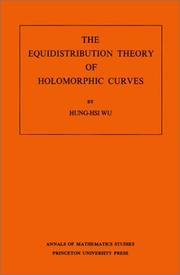
ISBN: 0691080739 1400881900 Year: 1970 Publisher: Tokyo : University of Tokyo press,
Abstract | Keywords | Export | Availability | Bookmark
 Loading...
Loading...Choose an application
- Reference Manager
- EndNote
- RefWorks (Direct export to RefWorks)
This work is a fresh presentation of the Ahlfors-Weyl theory of holomorphic curves that takes into account some recent developments in Nevanlinna theory and several complex variables. The treatment is differential geometric throughout, and assumes no previous acquaintance with the classical theory of Nevanlinna. The main emphasis is on holomorphic curves defined over Riemann surfaces, which admit a harmonic exhaustion, and the main theorems of the subject are proved for such surfaces. The author discusses several directions for further research.
Analytic functions. --- Functions, Meromorphic. --- Value distribution theory. --- Meromorphic functions --- Functions, Analytic --- Functions, Monogenic --- Functions, Regular --- Regular functions --- Functions of complex variables --- Series, Taylor's --- Distribution of values theory --- Functions, Entire --- Functions, Meromorphic --- Addition. --- Algebraic curve. --- Algebraic number. --- Atlas (topology). --- Binomial coefficient. --- Cauchy–Riemann equations. --- Compact Riemann surface. --- Compact space. --- Complex manifold. --- Complex projective space. --- Computation. --- Continuous function (set theory). --- Covariant derivative. --- Critical value. --- Curvature form. --- Diagram (category theory). --- Differential form. --- Differential geometry of surfaces. --- Differential geometry. --- Dimension. --- Divisor. --- Essential singularity. --- Euler characteristic. --- Existential quantification. --- Fiber bundle. --- Gaussian curvature. --- Geodesic curvature. --- Geometry. --- Grassmannian. --- Harmonic function. --- Hermann Weyl. --- Hermitian manifold. --- Holomorphic function. --- Homology (mathematics). --- Hyperbolic manifold. --- Hyperplane. --- Hypersurface. --- Improper integral. --- Intersection number (graph theory). --- Isometry. --- Line integral. --- Manifold. --- Meromorphic function. --- Minimal surface. --- Nevanlinna theory. --- One-form. --- Open problem. --- Open set. --- Orthogonal complement. --- Parameter. --- Picard theorem. --- Product metric. --- Q.E.D. --- Remainder. --- Riemann sphere. --- Riemann surface. --- Smoothness. --- Special case. --- Submanifold. --- Subset. --- Tangent space. --- Tangent. --- Theorem. --- Three-dimensional space (mathematics). --- Unit circle. --- Unit vector. --- Vector field. --- Volume element. --- Volume form. --- Fonctions de plusieurs variables complexes
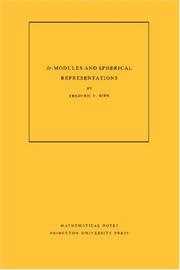
ISBN: 1400862078 9781400862078 0691025177 9780691608327 9780691025179 0691025177 0691608326 9780691608327 Year: 2014 Publisher: Princeton, NJ
Abstract | Keywords | Export | Availability | Bookmark
 Loading...
Loading...Choose an application
- Reference Manager
- EndNote
- RefWorks (Direct export to RefWorks)
The theory of D-modules deals with the algebraic aspects of differential equations. These are particularly interesting on homogeneous manifolds, since the infinitesimal action of a Lie algebra consists of differential operators. Hence, it is possible to attach geometric invariants, like the support and the characteristic variety, to representations of Lie groups. By considering D-modules on flag varieties, one obtains a simple classification of all irreducible admissible representations of reductive Lie groups. On the other hand, it is natural to study the representations realized by functions on pseudo-Riemannian symmetric spaces, i.e., spherical representations. The problem is then to describe the spherical representations among all irreducible ones, and to compute their multiplicities. This is the goal of this work, achieved fairly completely at least for the discrete series representations of reductive symmetric spaces. The book provides a general introduction to the theory of D-modules on flag varieties, and it describes spherical D-modules in terms of a cohomological formula. Using microlocalization of representations, the author derives a criterion for irreducibility. The relation between multiplicities and singularities is also discussed at length.Originally published in 1990.The Princeton Legacy Library uses the latest print-on-demand technology to again make available previously out-of-print books from the distinguished backlist of Princeton University Press. These editions preserve the original texts of these important books while presenting them in durable paperback and hardcover editions. The goal of the Princeton Legacy Library is to vastly increase access to the rich scholarly heritage found in the thousands of books published by Princeton University Press since its founding in 1905.
Differentiable manifolds. --- D-modules. --- Representations of groups. --- Lie groups. --- Groups, Lie --- Lie algebras --- Symmetric spaces --- Topological groups --- Group representation (Mathematics) --- Groups, Representation theory of --- Group theory --- Modules (Algebra) --- Differential manifolds --- Manifolds (Mathematics) --- Affine space. --- Algebraic cycle. --- Algebraic element. --- Analytic function. --- Annihilator (ring theory). --- Automorphism. --- Banach space. --- Base change. --- Big O notation. --- Bijection. --- Bilinear form. --- Borel subgroup. --- Cartan subalgebra. --- Cofibration. --- Cohomology. --- Commutative diagram. --- Commutative property. --- Commutator subgroup. --- Complexification (Lie group). --- Conjugacy class. --- Coproduct. --- Coset. --- Cotangent space. --- D-module. --- Derived category. --- Diagram (category theory). --- Differential operator. --- Dimension (vector space). --- Direct image functor. --- Discrete series representation. --- Disk (mathematics). --- Dot product. --- Double coset. --- Eigenfunction. --- Eigenvalues and eigenvectors. --- Endomorphism. --- Euler operator. --- Existential quantification. --- Fibration. --- Function space. --- Functor. --- G-module. --- Gelfand pair. --- Generic point. --- Hilbert space. --- Holomorphic function. --- Homomorphism. --- Hyperfunction. --- Ideal (ring theory). --- Infinitesimal character. --- Inner automorphism. --- Invertible sheaf. --- Irreducibility (mathematics). --- Irreducible representation. --- Levi decomposition. --- Lie algebra. --- Line bundle. --- Linear algebraic group. --- Linear space (geometry). --- Manifold. --- Maximal compact subgroup. --- Maximal torus. --- Metric space. --- Module (mathematics). --- Moment map. --- Morphism. --- Noetherian ring. --- Open set. --- Presheaf (category theory). --- Principal series representation. --- Projective line. --- Projective object. --- Projective space. --- Projective variety. --- Reductive group. --- Riemannian geometry. --- Riemann–Hilbert correspondence. --- Right inverse. --- Ring (mathematics). --- Root system. --- Satake diagram. --- Sheaf (mathematics). --- Sheaf of modules. --- Special case. --- Sphere. --- Square-integrable function. --- Sub"ient. --- Subalgebra. --- Subcategory. --- Subgroup. --- Summation. --- Surjective function. --- Symmetric space. --- Symplectic geometry. --- Tensor product. --- Theorem. --- Triangular matrix. --- Vector bundle. --- Volume form. --- Weyl group.
Book
ISBN: 9781400862887 1400862884 0691635412 0691606706 Year: 2014 Publisher: Princeton, NJ
Abstract | Keywords | Export | Availability | Bookmark
 Loading...
Loading...Choose an application
- Reference Manager
- EndNote
- RefWorks (Direct export to RefWorks)
In Hypo-Analytic Structures Franois Treves provides a systematic approach to the study of the differential structures on manifolds defined by systems of complex vector fields. Serving as his main examples are the elliptic complexes, among which the De Rham and Dolbeault are the best known, and the tangential Cauchy-Riemann operators. Basic geometric entities attached to those structures are isolated, such as maximally real submanifolds and orbits of the system. Treves discusses the existence, uniqueness, and approximation of local solutions to homogeneous and inhomogeneous equations and delimits their supports. The contents of this book consist of many results accumulated in the last decade by the author and his collaborators, but also include classical results, such as the Newlander-Nirenberg theorem. The reader will find an elementary description of the FBI transform, as well as examples of its use. Treves extends the main approximation and uniqueness results to first-order nonlinear equations by means of the Hamiltonian lift.Originally published in 1993.The Princeton Legacy Library uses the latest print-on-demand technology to again make available previously out-of-print books from the distinguished backlist of Princeton University Press. These editions preserve the original texts of these important books while presenting them in durable paperback and hardcover editions. The goal of the Princeton Legacy Library is to vastly increase access to the rich scholarly heritage found in the thousands of books published by Princeton University Press since its founding in 1905.
Differential equations, Partial. --- Manifolds (Mathematics) --- Vector fields. --- Direction fields (Mathematics) --- Fields, Direction (Mathematics) --- Fields, Slope (Mathematics) --- Fields, Vector --- Slope fields (Mathematics) --- Vector analysis --- Geometry, Differential --- Topology --- Partial differential equations --- Algebra homomorphism. --- Analytic function. --- Automorphism. --- Basis (linear algebra). --- Bijection. --- Bounded operator. --- C0. --- CR manifold. --- Cauchy problem. --- Cauchy sequence. --- Cauchy–Riemann equations. --- Characterization (mathematics). --- Coefficient. --- Cohomology. --- Commutative property. --- Commutator. --- Complex dimension. --- Complex manifold. --- Complex number. --- Complex space. --- Complex-analytic variety. --- Continuous function (set theory). --- Corollary. --- Coset. --- De Rham cohomology. --- Diagram (category theory). --- Diffeomorphism. --- Differential form. --- Differential operator. --- Dimension (vector space). --- Dirac delta function. --- Dirac measure. --- Eigenvalues and eigenvectors. --- Embedding. --- Equation. --- Exact differential. --- Existential quantification. --- Exterior algebra. --- F-space. --- Formal power series. --- Frobenius theorem (differential topology). --- Frobenius theorem (real division algebras). --- H-vector. --- Hadamard three-circle theorem. --- Hahn–Banach theorem. --- Holomorphic function. --- Hypersurface. --- Hölder condition. --- Identity matrix. --- Infimum and supremum. --- Integer. --- Integral equation. --- Integral transform. --- Intersection (set theory). --- Jacobian matrix and determinant. --- Linear differential equation. --- Linear equation. --- Linear map. --- Lipschitz continuity. --- Manifold. --- Mean value theorem. --- Method of characteristics. --- Monomial. --- Multi-index notation. --- Neighbourhood (mathematics). --- Norm (mathematics). --- One-form. --- Open mapping theorem (complex analysis). --- Open mapping theorem. --- Open set. --- Ordinary differential equation. --- Partial differential equation. --- Poisson bracket. --- Polynomial. --- Power series. --- Projection (linear algebra). --- Pullback (category theory). --- Pullback (differential geometry). --- Pullback. --- Riemann mapping theorem. --- Riemann surface. --- Ring homomorphism. --- Sesquilinear form. --- Sobolev space. --- Special case. --- Stokes' theorem. --- Stone–Weierstrass theorem. --- Submanifold. --- Subset. --- Support (mathematics). --- Surjective function. --- Symplectic geometry. --- Symplectic vector space. --- Taylor series. --- Theorem. --- Unit disk. --- Upper half-plane. --- Vector bundle. --- Vector field. --- Volume form.
Book
ISBN: 1400882419 Year: 2016 Publisher: Princeton, NJ : Princeton University Press,
Abstract | Keywords | Export | Availability | Bookmark
 Loading...
Loading...Choose an application
- Reference Manager
- EndNote
- RefWorks (Direct export to RefWorks)
The subject matter of this work is an area of Lorentzian geometry which has not been heretofore much investigated: Do there exist Lorentzian manifolds all of whose light-like geodesics are periodic? A surprising fact is that such manifolds exist in abundance in (2 + 1)-dimensions (though in higher dimensions they are quite rare). This book is concerned with the deformation theory of M2,1 (which furnishes almost all the known examples of these objects). It also has a section describing conformal invariants of these objects, the most interesting being the determinant of a two dimensional "Floquet operator," invented by Paneitz and Segal.
Cosmology --- Geometry, Differential. --- Lorentz transformations. --- Mathematical models. --- Automorphism. --- Bijection. --- C0. --- Canonical form. --- Canonical transformation. --- Cauchy distribution. --- Causal structure. --- Cayley transform. --- Codimension. --- Cohomology. --- Cokernel. --- Compactification (mathematics). --- Complexification (Lie group). --- Computation. --- Conformal geometry. --- Conformal map. --- Conformal symmetry. --- Connected sum. --- Contact geometry. --- Corank. --- Covariant derivative. --- Covering space. --- Deformation theory. --- Diagram (category theory). --- Diffeomorphism. --- Differentiable manifold. --- Differential operator. --- Dimension (vector space). --- Einstein field equations. --- Equation. --- Euler characteristic. --- Existential quantification. --- Fiber bundle. --- Fibration. --- Floquet theory. --- Four-dimensional space. --- Fourier integral operator. --- Fourier transform. --- Fundamental group. --- Geodesic. --- Hamilton–Jacobi equation. --- Hilbert space. --- Holomorphic function. --- Holomorphic vector bundle. --- Hyperfunction. --- Hypersurface. --- Integral curve. --- Integral geometry. --- Integral transform. --- Intersection (set theory). --- Invertible matrix. --- K-finite. --- Lagrangian (field theory). --- Lie algebra. --- Light cone. --- Linear map. --- Manifold. --- Maxima and minima. --- Minkowski space. --- Module (mathematics). --- Notation. --- One-parameter group. --- Parametrix. --- Parametrization. --- Principal bundle. --- Product metric. --- Pseudo-differential operator. --- Quadratic equation. --- Quadratic form. --- Quadric. --- Radon transform. --- Riemann surface. --- Riemannian manifold. --- Seifert fiber space. --- Sheaf (mathematics). --- Siegel domain. --- Simply connected space. --- Submanifold. --- Submersion (mathematics). --- Support (mathematics). --- Surjective function. --- Symplectic manifold. --- Symplectic vector space. --- Symplectomorphism. --- Tangent space. --- Tautology (logic). --- Tensor product. --- Theorem. --- Topological space. --- Topology. --- Two-dimensional space. --- Unit vector. --- Universal enveloping algebra. --- Variable (mathematics). --- Vector bundle. --- Vector field. --- Vector space. --- Verma module. --- Volume form. --- X-ray transform.
Book
ISBN: 0691141843 0691141851 9786612303807 1282303805 1400831067 9781400831067 9781282303805 9780691141848 9780691141855 Year: 2009 Volume: 172 Publisher: Princeton, NJ
Abstract | Keywords | Export | Availability | Bookmark
 Loading...
Loading...Choose an application
- Reference Manager
- EndNote
- RefWorks (Direct export to RefWorks)
The results established in this book constitute a new departure in ergodic theory and a significant expansion of its scope. Traditional ergodic theorems focused on amenable groups, and relied on the existence of an asymptotically invariant sequence in the group, the resulting maximal inequalities based on covering arguments, and the transference principle. Here, Alexander Gorodnik and Amos Nevo develop a systematic general approach to the proof of ergodic theorems for a large class of non-amenable locally compact groups and their lattice subgroups. Simple general conditions on the spectral theory of the group and the regularity of the averaging sets are formulated, which suffice to guarantee convergence to the ergodic mean. In particular, this approach gives a complete solution to the problem of establishing mean and pointwise ergodic theorems for the natural averages on semisimple algebraic groups and on their discrete lattice subgroups. Furthermore, an explicit quantitative rate of convergence to the ergodic mean is established in many cases. The topic of this volume lies at the intersection of several mathematical fields of fundamental importance. These include ergodic theory and dynamics of non-amenable groups, harmonic analysis on semisimple algebraic groups and their homogeneous spaces, quantitative non-Euclidean lattice point counting problems and their application to number theory, as well as equidistribution and non-commutative Diophantine approximation. Many examples and applications are provided in the text, demonstrating the usefulness of the results established.
Dynamics. --- Ergodic theory. --- Harmonic analysis. --- Lattice theory. --- Lie groups. --- Ergodic theory --- Lie groups --- Lattice theory --- Harmonic analysis --- Dynamics --- Calculus --- Mathematics --- Physical Sciences & Mathematics --- Dynamical systems --- Kinetics --- Analysis (Mathematics) --- Functions, Potential --- Potential functions --- Lattices (Mathematics) --- Space lattice (Mathematics) --- Structural analysis (Mathematics) --- Groups, Lie --- Ergodic transformations --- Mechanics, Analytic --- Force and energy --- Mechanics --- Physics --- Statics --- Banach algebras --- Mathematical analysis --- Bessel functions --- Fourier series --- Harmonic functions --- Time-series analysis --- Algebra, Abstract --- Algebra, Boolean --- Group theory --- Set theory --- Topology --- Transformations (Mathematics) --- Crystallography, Mathematical --- Lie algebras --- Symmetric spaces --- Topological groups --- Continuous groups --- Mathematical physics --- Measure theory --- Absolute continuity. --- Algebraic group. --- Amenable group. --- Asymptote. --- Asymptotic analysis. --- Asymptotic expansion. --- Automorphism. --- Borel set. --- Bounded function. --- Bounded operator. --- Bounded set (topological vector space). --- Congruence subgroup. --- Continuous function. --- Convergence of random variables. --- Convolution. --- Coset. --- Counting problem (complexity). --- Counting. --- Differentiable function. --- Dimension (vector space). --- Diophantine approximation. --- Direct integral. --- Direct product. --- Discrete group. --- Embedding. --- Equidistribution theorem. --- Ergodicity. --- Estimation. --- Explicit formulae (L-function). --- Family of sets. --- Haar measure. --- Hilbert space. --- Hyperbolic space. --- Induced representation. --- Infimum and supremum. --- Initial condition. --- Interpolation theorem. --- Invariance principle (linguistics). --- Invariant measure. --- Irreducible representation. --- Isometry group. --- Iwasawa group. --- Lattice (group). --- Lie algebra. --- Linear algebraic group. --- Linear space (geometry). --- Lipschitz continuity. --- Mass distribution. --- Mathematical induction. --- Maximal compact subgroup. --- Maximal ergodic theorem. --- Measure (mathematics). --- Mellin transform. --- Metric space. --- Monotonic function. --- Neighbourhood (mathematics). --- Normal subgroup. --- Number theory. --- One-parameter group. --- Operator norm. --- Orthogonal complement. --- P-adic number. --- Parametrization. --- Parity (mathematics). --- Pointwise convergence. --- Pointwise. --- Principal homogeneous space. --- Principal series representation. --- Probability measure. --- Probability space. --- Probability. --- Rate of convergence. --- Regular representation. --- Representation theory. --- Resolution of singularities. --- Sobolev space. --- Special case. --- Spectral gap. --- Spectral method. --- Spectral theory. --- Square (algebra). --- Subgroup. --- Subsequence. --- Subset. --- Symmetric space. --- Tensor algebra. --- Tensor product. --- Theorem. --- Transfer principle. --- Unit sphere. --- Unit vector. --- Unitary group. --- Unitary representation. --- Upper and lower bounds. --- Variable (mathematics). --- Vector group. --- Vector space. --- Volume form. --- Word metric.

ISBN: 0691085420 1400883911 9781400883912 9780691085425 Year: 2016 Volume: 38 Publisher: Princeton, NJ
Abstract | Keywords | Export | Availability | Bookmark
 Loading...
Loading...Choose an application
- Reference Manager
- EndNote
- RefWorks (Direct export to RefWorks)
This book offers a systematic and comprehensive presentation of the concepts of a spin manifold, spinor fields, Dirac operators, and A-genera, which, over the last two decades, have come to play a significant role in many areas of modern mathematics. Since the deeper applications of these ideas require various general forms of the Atiyah-Singer Index Theorem, the theorems and their proofs, together with all prerequisite material, are examined here in detail. The exposition is richly embroidered with examples and applications to a wide spectrum of problems in differential geometry, topology, and mathematical physics. The authors consistently use Clifford algebras and their representations in this exposition. Clifford multiplication and Dirac operator identities are even used in place of the standard tensor calculus. This unique approach unifies all the standard elliptic operators in geometry and brings fresh insights into curvature calculations. The fundamental relationships of Clifford modules to such topics as the theory of Lie groups, K-theory, KR-theory, and Bott Periodicity also receive careful consideration. A special feature of this book is the development of the theory of Cl-linear elliptic operators and the associated index theorem, which connects certain subtle spin-corbordism invariants to classical questions in geometry and has led to some of the most profound relations known between the curvature and topology of manifolds.
Algebres de Clifford --- Clifford [Algebra's van ] --- Clifford algebras --- Fysica [Mathematische ] --- Fysica [Wiskundige ] --- Mathematische fysica --- Physics -- Mathematics --- Physics [Mathematical ] --- Physique -- Mathématiques --- Physique -- Méthodes mathématiques --- Wiskundige fysica --- Clifford, Algèbres de --- Spin, Nuclear --- Geometric algebras --- Clifford algebras. --- Spin geometry. --- Clifford, Algèbres de --- Spin geometry --- 514.76 --- Algebras, Linear --- 514.76 Geometry of differentiable manifolds and of their submanifolds --- Geometry of differentiable manifolds and of their submanifolds --- Global differential geometry --- Geometry --- Mathematical physics --- Topology --- Nuclear spin --- -Mathematics --- Géométrie --- Physique mathématique --- Spin nucléaire --- Topologie --- Mathematics --- Mathématiques --- Algebraic theory. --- Atiyah–Singer index theorem. --- Automorphism. --- Betti number. --- Binary icosahedral group. --- Binary octahedral group. --- Bundle metric. --- C*-algebra. --- Calabi conjecture. --- Calabi–Yau manifold. --- Cartesian product. --- Classification theorem. --- Clifford algebra. --- Cobordism. --- Cohomology ring. --- Cohomology. --- Cokernel. --- Complete metric space. --- Complex manifold. --- Complex vector bundle. --- Complexification (Lie group). --- Covering space. --- Diffeomorphism. --- Differential topology. --- Dimension (vector space). --- Dimension. --- Dirac operator. --- Disk (mathematics). --- Dolbeault cohomology. --- Einstein field equations. --- Elliptic operator. --- Equivariant K-theory. --- Exterior algebra. --- Fiber bundle. --- Fixed-point theorem. --- Fourier inversion theorem. --- Fundamental group. --- Gauge theory. --- Geometry. --- Hilbert scheme. --- Holonomy. --- Homotopy sphere. --- Homotopy. --- Hyperbolic manifold. --- Induced homomorphism. --- Intersection form (4-manifold). --- Isomorphism class. --- J-invariant. --- K-theory. --- Kähler manifold. --- Laplace operator. --- Lie algebra. --- Lorentz covariance. --- Lorentz group. --- Manifold. --- Mathematical induction. --- Metric connection. --- Minkowski space. --- Module (mathematics). --- N-sphere. --- Operator (physics). --- Orthonormal basis. --- Principal bundle. --- Projective space. --- Pseudo-Riemannian manifold. --- Pseudo-differential operator. --- Quadratic form. --- Quaternion. --- Quaternionic projective space. --- Ricci curvature. --- Riemann curvature tensor. --- Riemannian geometry. --- Riemannian manifold. --- Ring homomorphism. --- Scalar curvature. --- Scalar multiplication. --- Sign (mathematics). --- Space form. --- Sphere theorem. --- Spin representation. --- Spin structure. --- Spinor bundle. --- Spinor field. --- Spinor. --- Subgroup. --- Support (mathematics). --- Symplectic geometry. --- Tangent bundle. --- Tangent space. --- Tensor calculus. --- Tensor product. --- Theorem. --- Topology. --- Unit disk. --- Unit sphere. --- Variable (mathematics). --- Vector bundle. --- Vector field. --- Vector space. --- Volume form. --- Nuclear spin - - Mathematics --- -Clifford algebras.
| Listing 1 - 10 of 10 |
Sort by
|

 Search
Search Feedback
Feedback About UniCat
About UniCat  Help
Help News
News